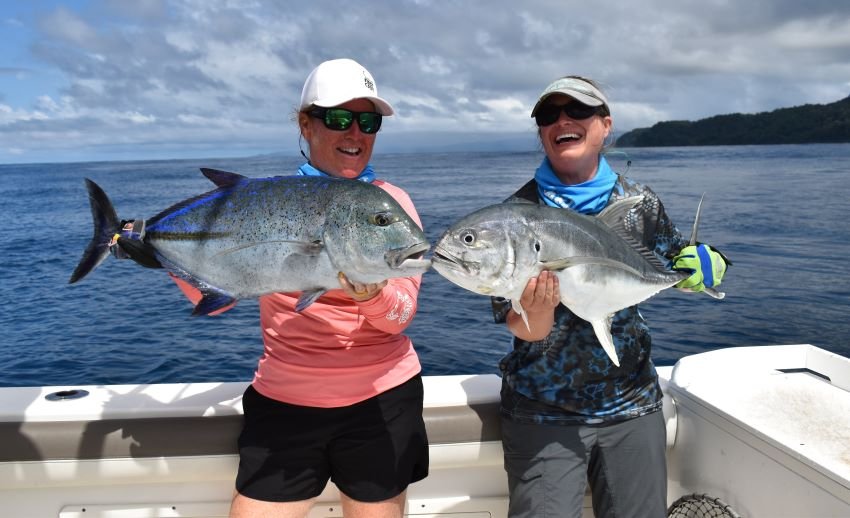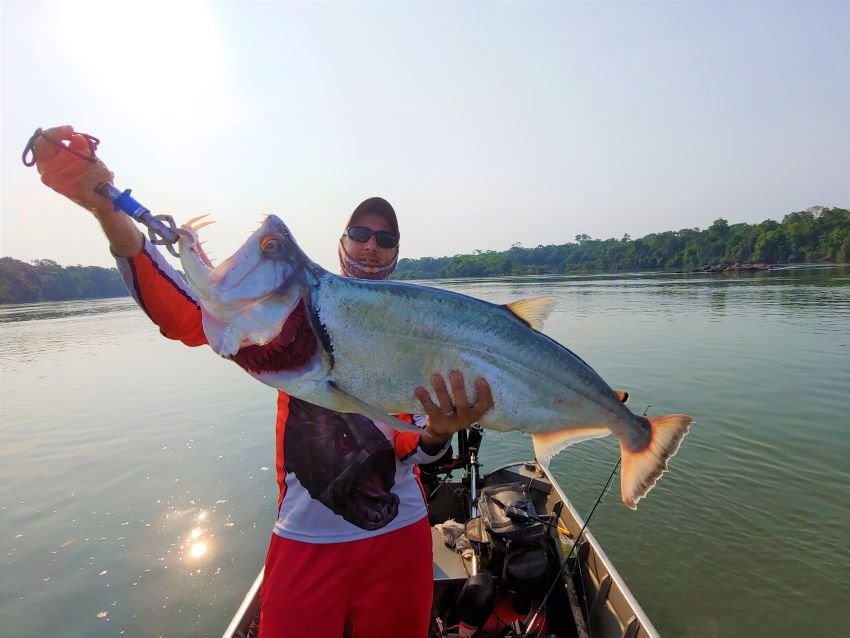Yes, the Perfect Multi-Species Fishing Vacation Exists
Despite Hanna’s claims to the contrary, when we go to Lake El Salto or Lake Picachos, we are there to target one species of fish: trophy largemouth bass. Indeed, some of our favorite destinations are focused on chasing a particularly desirable, elusive or hard-fighting fish. On the other hand, there’s definitely nothing wrong with a trip to a multi-species Shangri-la. Over the past several years some of our most memorable adventures have been to places where we could (and did) target multiple kinds of fish. For example:
Panama – At Sport Fish Panama Island Lodge we’ve caught tuna, mahi, snapper, roosterfish, trevally and other species, and there are also billfish in the mix.
Alaska – At Bear Trail Lodge, we’ve caught rainbow trout, silver salmon, chum salmon, king salmon, Dolly Varden and grayling (and in 2019 I added on a halibut side-trip).
St. Clair – While I’ve only fished St. Clair for muskies, on one of her ladies’ trips Hanna hired guides for a smallmouth/walleye combo.
Lake of the Woods – At Ballard’s Black Island we primarily chased smallmouths, but muskies, pike, walleye, sauger, crappie and perch were also present.
The Amazon – On our two trips to the Rio Negro region, we primarily targeted peacock bass, although several other species (jacunda, piranha, arowana, etc.) ate our lures on occasion. When I visited Mato Grosso in 2019, we targeted wolf fish, payara, bicuda and other species, and took a side trip for small peacocks one day.
I’d count all of those trips as successes, but sometimes there can be too much of a good thing. Abundance can distract you and prevent you from achieving otherwise-achievable goals. I’d never tell someone NOT to go to a multi-species fishery – indeed, that’s a huge factor in favor of visiting certain places – but as with everything else it pays to have a strategy to make the most of your vacation. Here are steps to consider when making your choices and developing plans:
Make Sure They Actually Live There In Numbers
Someone once caught a musky or a marlin or a tarpon where you’re going? Not the greatest odds in the world. It sounds simple, but so many people overlook the fact – if you want a true multispecies experience go where those different types of fish are expected, not occasional. A member of my bass club once caught a rainbow trout from under a dock on the Tidal Potomac River – it even made the newspaper – but if you head to the Nation’s River with your Royal Coachmen and Muddler Minnows looking for trout you’ll likely go home disappointed. Also, if a fishery is known for one species in particular, plan to focus on them with anything else as a pleasant bonus. For example, when we go to Casa Vieja Lodge in Guatemala, we know that there’s a chance at a mahi, or a yellowfin or a marlin every day, but it’s sailfish that are the star of the show there, so that’s what we target.
Go When the Fish Are In Season
It may be the greatest bluefin tuna fishery in the world, or Alaska’s best king salmon river, but if the fish aren’t there when you are, you can’t target them effectively. If possible, go at the height of their presence. This is especially true with anadromous or migratory species, but to some extent it applies to everything. Even if the fish are in your targeted waters, make sure that it’s open season to actively target them – otherwise you risk an ethical lapse and/or a violation of the law. Finally, if you intend to catch-and-keep (i.e., keep some fish for the plate) versus catch and release, confirm that you’ll be able to do so, and then check the number and size limits so that you’ll target the right populations.
Be Realistic About Your Options and Time-Management
If you’re going to a fly-in Canadian lake, intending to catch muskies, but also hoping to catch walleyes, smallmouths and/or lake trout, keep your expectations consistent with the fishery’s history. Do they produce muskies every day? Or does the lake produce just follows and an average of one hookup per angler per week? That will help you apportion your time wisely. If you must have some walleyes for shore lunch, then devote some time to that every day, but not so much that it’ll cut into prime musky fishing hours. Are you going to be mad if you go home without giving muskies your best shot? Or will you be angrier if you don’t catch anything at all? That may determine how you divide your days. On fisheries where there’s a choice of mutually-exclusive areas on a given day (e.g., inshore vs. offshore in a saltwater fishery, or the home river vs. a flyout in Alaska) look at weather patterns for the entirety of the trip before making your choices, too. For example, one day it might be too rough to go offshore, so use that as your inshore day.
Have the Right Gear, the Right Guide and the Right Plan
If you’re headed to a noted multispecies fishery, make sure that your guide, lodge or outfitter is aware of that plan and equipped to make it happen. If you go to St. Clair seeking smallmouths and walleyes, it might not be wise to hire a muskies-only big fish hunter. Some of them moonlight on those other species, but if they’re not psyched about it, it will show in their attitude and possibly in your results. Similarly, if you are fly-only or conventional gear only, tell them ahead of time so that they have the right stuff on hand – or can advise you to bring it with you. Be frank with them up front about your preferences and expectations, so that they can build that into their game plan, or encourage you to come up with a new plan altogether.
Flexibility is Critical
Finally, if you think that dialing in one species of fish can be difficult, even on world class waters, with each additional target you’re increasing the level of difficulty substantially, if not exponentially. If muskies or marlin or tarpon are your dream fish, and that’s all you care about, you might be willing to forego all others to make that dream come true, but if that species is clearly “off” while you’re there, it may pay to salvage the trip by turning to something else altogether. It just depends on the particular circumstances at hand and what you characterize as a “successful” trip. Sometimes being stubborn-bordering-on-pigheaded pays off, but often it’ll leave you regretting your choices. I’m not saying that the marlin fanatic should resort to catching porgies off the dock, but sometimes in the face of overwhelming odds against you there’s a way to turn chicken shit into chicken salad.









